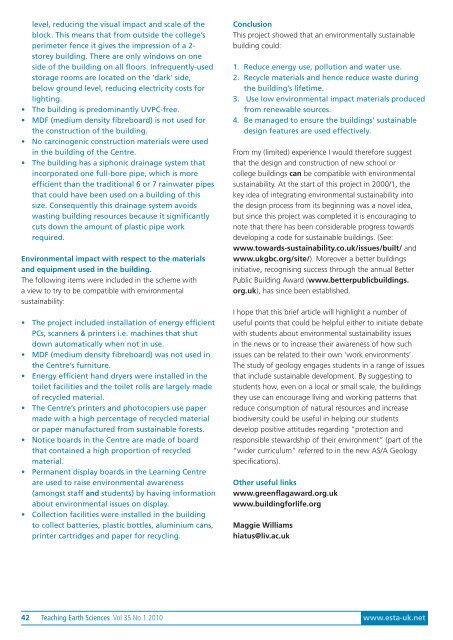Teaching Earth Sciences - Earth Science Teachers' Association
Teaching Earth Sciences - Earth Science Teachers' Association
Teaching Earth Sciences - Earth Science Teachers' Association
Create successful ePaper yourself
Turn your PDF publications into a flip-book with our unique Google optimized e-Paper software.
level, reducing the visual impact and scale of the<br />
block. This means that from outside the college’s<br />
perimeter fence it gives the impression of a 2-<br />
storey building. There are only windows on one<br />
side of the building on all floors. Infrequently-used<br />
storage rooms are located on the ‘dark’ side,<br />
below ground level, reducing electricity costs for<br />
lighting.<br />
• The building is predominantly UVPC-free.<br />
• MDF (medium density fibreboard) is not used for<br />
the construction of the building.<br />
• No carcinogenic construction materials were used<br />
in the building of the Centre.<br />
• The building has a siphonic drainage system that<br />
incorporated one full-bore pipe, which is more<br />
efficient than the traditional 6 or 7 rainwater pipes<br />
that could have been used on a building of this<br />
size. Consequently this drainage system avoids<br />
wasting building resources because it significantly<br />
cuts down the amount of plastic pipe work<br />
required.<br />
Environmental impact with respect to the materials<br />
and equipment used in the building.<br />
The following items were included in the scheme with<br />
a view to try to be compatible with environmental<br />
sustainability:<br />
• The project included installation of energy efficient<br />
PCs, scanners & printers i.e. machines that shut<br />
down automatically when not in use.<br />
• MDF (medium density fibreboard) was not used in<br />
the Centre’s furniture.<br />
• Energy efficient hand dryers were installed in the<br />
toilet facilities and the toilet rolls are largely made<br />
of recycled material.<br />
• The Centre’s printers and photocopiers use paper<br />
made with a high percentage of recycled material<br />
or paper manufactured from sustainable forests.<br />
• Notice boards in the Centre are made of board<br />
that contained a high proportion of recycled<br />
material.<br />
• Permanent display boards in the Learning Centre<br />
are used to raise environmental awareness<br />
(amongst staff and students) by having information<br />
about environmental issues on display.<br />
• Collection facilities were installed in the building<br />
to collect batteries, plastic bottles, aluminium cans,<br />
printer cartridges and paper for recycling.<br />
Conclusion<br />
This project showed that an environmentally sustainable<br />
building could:<br />
1. Reduce energy use, pollution and water use.<br />
2. Recycle materials and hence reduce waste during<br />
the building’s lifetime.<br />
3. Use low environmental impact materials produced<br />
from renewable sources.<br />
4. Be managed to ensure the buildings’ sustainable<br />
design features are used effectively.<br />
From my (limited) experience I would therefore suggest<br />
that the design and construction of new school or<br />
college buildings can be compatible with environmental<br />
sustainability. At the start of this project in 2000/1, the<br />
key idea of integrating environmental sustainability into<br />
the design process from its beginning was a novel idea,<br />
but since this project was completed it is encouraging to<br />
note that there has been considerable progress towards<br />
developing a code for sustainable buildings. (See:<br />
www.towards-sustainability.co.uk/issues/built/ and<br />
www.ukgbc.org/site/). Moreover a better buildings<br />
initiative, recognising success through the annual Better<br />
Public Building Award (www.betterpublicbuildings.<br />
org.uk), has since been established.<br />
I hope that this brief article will highlight a number of<br />
useful points that could be helpful either to initiate debate<br />
with students about environmental sustainability issues<br />
in the news or to increase their awareness of how such<br />
issues can be related to their own ‘work environments’.<br />
The study of geology engages students in a range of issues<br />
that include sustainable development. By suggesting to<br />
students how, even on a local or small scale, the buildings<br />
they use can encourage living and working patterns that<br />
reduce consumption of natural resources and increase<br />
biodiversity could be useful in helping our students<br />
develop positive attitudes regarding “protection and<br />
responsible stewardship of their environment” (part of the<br />
“wider curriculum” referred to in the new AS/A Geology<br />
specifications).<br />
Other useful links<br />
www.greenflagaward.org.uk<br />
www.buildingforlife.org<br />
Maggie Williams<br />
hiatus@liv.ac.uk<br />
42 <strong>Teaching</strong> <strong>Earth</strong> <strong><strong>Science</strong>s</strong> Vol 35 No 1 2010 www.esta-uk.net

















